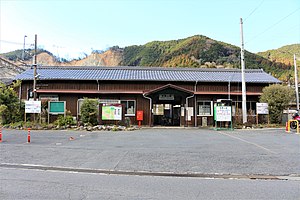Yoshinoguchi Station (吉野口駅, Yoshinoguchi-eki) is a junction passenger railway station located in the city of Gose, Nara Prefecture, Japan. It is jointly operated by the West Japan Railway Company (JR West) and the private transportation company, Kintetsu Railway.[1]
| commuter rail station | |||||||||||||||||||||||||||||||||||||||||||||
 | |||||||||||||||||||||||||||||||||||||||||||||
| General information | |||||||||||||||||||||||||||||||||||||||||||||
| Location | 442, Furuse, Gose-shi, Nara-ken 639-2254 Japan | ||||||||||||||||||||||||||||||||||||||||||||
| Coordinates | 34°25′14″N 135°45′02″E / 34.420558°N 135.750653°E | ||||||||||||||||||||||||||||||||||||||||||||
| Owned by |
| ||||||||||||||||||||||||||||||||||||||||||||
| Operated by |
| ||||||||||||||||||||||||||||||||||||||||||||
| Line(s) | |||||||||||||||||||||||||||||||||||||||||||||
| Distance |
| ||||||||||||||||||||||||||||||||||||||||||||
| Platforms |
| ||||||||||||||||||||||||||||||||||||||||||||
| Tracks |
| ||||||||||||||||||||||||||||||||||||||||||||
| Train operators | |||||||||||||||||||||||||||||||||||||||||||||
| Bus stands | 1 | ||||||||||||||||||||||||||||||||||||||||||||
| Connections | |||||||||||||||||||||||||||||||||||||||||||||
| Construction | |||||||||||||||||||||||||||||||||||||||||||||
| Structure type | At grade | ||||||||||||||||||||||||||||||||||||||||||||
| Parking | |||||||||||||||||||||||||||||||||||||||||||||
| Bicycle facilities | |||||||||||||||||||||||||||||||||||||||||||||
| Accessible | Yes (2 accessible slopes between the ticket gate and the northbound platform) | ||||||||||||||||||||||||||||||||||||||||||||
| Other information | |||||||||||||||||||||||||||||||||||||||||||||
| Station code | Kintetsu: F48 | ||||||||||||||||||||||||||||||||||||||||||||
| Website | http://www.jr-odekake.net/eki/top.php?id=0621809 www | ||||||||||||||||||||||||||||||||||||||||||||
| History | |||||||||||||||||||||||||||||||||||||||||||||
| Opened | 10 May 1896 | ||||||||||||||||||||||||||||||||||||||||||||
| Rebuilt | 1912 | ||||||||||||||||||||||||||||||||||||||||||||
| Electrified |
| ||||||||||||||||||||||||||||||||||||||||||||
| Previous names | Kuzu (1896—1903) | ||||||||||||||||||||||||||||||||||||||||||||
| Passengers | |||||||||||||||||||||||||||||||||||||||||||||
| 2012 / 2015 |
| ||||||||||||||||||||||||||||||||||||||||||||
| |||||||||||||||||||||||||||||||||||||||||||||
| |||||||||||||||||||||||||||||||||||||||||||||
Lines
editYoshinoguchi Station is served by the Wakayama Line and is 24.9 kilometers from the terminus of that line at Ōji. its is also served by the Yoshino Line and is 9.5 kilometers from the starting point of the line at Kashiharajingū-mae and 49.2 kilometers from Osaka Abenobashi.
Layout
editThe station is an above-ground station with a total of three platforms and five tracks, one side platform and two island platforms with four tracks, and the old wooden station building from when the station first opened still remains. JR uses two platforms and three tracks, while Kintetsu uses two platforms and two tracks, (one of the island platforms is shared by JR and Kintetsu). Therefore, it is possible to transfer between JR and Kintetsu within the ticket gates, and in certain cases, it is possible to transfer on the same platform. The station building is on the east side, and is connected to the island platform by an underground passage. There are more Kintetsu trains, and the longest trains that currently stop there are four cars for both JR and Kintetsu. The station name signs are standardized to JR West specifications, including the Kintetsu Line platforms, but the Kintetsu Line platforms do not have the JR logo, but instead have the Kintetsu station number. The JR station is staffed. [2]
Platforms
edit| 1 | ■ Yoshino Line—Local | for Yoshino and Muda |
| ■ Yoshino Line—Semi-express | for Yoshino | |
| ■ Yoshino Line—Express | for Yoshino | |
| ■ Yoshino Line—Limited Express | for Yoshino | |
| ■ Yoshino Line—Limited Express Sakura Liner | for Yoshino | |
| 2 | ■ Yoshino Line—Local | for Ōsaka-Abenobashi, Furuichi, and Kashiharajingū-mae |
| ■ Yoshino Line—Semi-express | for Ōsaka-Abenobashi | |
| ■ Yoshino Line—Express | for Ōsaka-Abenobashi | |
| ■ Yoshino Line—Limited Express | for Ōsaka-Abenobashi | |
| ■ Yoshino Line—Limited Express Sakura Liner | for Ōsaka-Abenobashi | |
| 3 | ■ Wakayama Line—Local | for Gojō, Kokawa, and Wakayama |
| ■ Wakayama Line—Regional Rapid Service | for Gojō | |
| ■ Wakayama Line—Yamatoji Rapid Service | for Gojō | |
| 4 | ■ Wakayama Line—Local | for Takada, Ōji and Nara |
| ■ Wakayama Line—Rapid Service | for JR Namba | |
| 5 | ■ Wakayama Line—Local | for Ōji |
History
editYoshinoguchi Station was opened 10 May 1896 as Kuzu Station (葛駅) on the Nanwa Railway. It was renamed to its present name on 15 May 1903. In 1904, the Kansai Railway took over the Nanwa Railway, and was nationalized in 1907. On 15 October 1912, the Yoshino Light Railway (the predecessor of the Kintetsu Yoshino Line) began operations. Through a number of mergers , this became the Kintetsu Railway on 1 June 1944.
Passenger statistics
editIn fiscal 2019 the JR portion of the station was used by an average of 587 passengers daily (boarding passengers only).[3] The Kintetsu portion of the station was used by 714 passengers daily.
Surrounding area
edit- Japan National Route 309
- Gose City Kuzu Elementary and Junior High School
- Japan Pharmaceutical Manufacturing Head Office
See also
editReferences
edit- ^ Terada, Hirokazu (July 2002). データブック日本の私鉄 [Databook: Japan's Private Railways]. Japan: Neko Publishing. ISBN 4-87366-874-3.
- ^ "吉野口駅" [Yoshinoguchi Station]. hacchi-no-he.net. Retrieved 16 March 2018.
- ^ Nara Prefecture Statistical Yearbook
External links
editMedia related to Yoshinoguchi Station at Wikimedia Commons
- Official website (JR-West) (in Japanese)
- Official website (Kintetsu)
